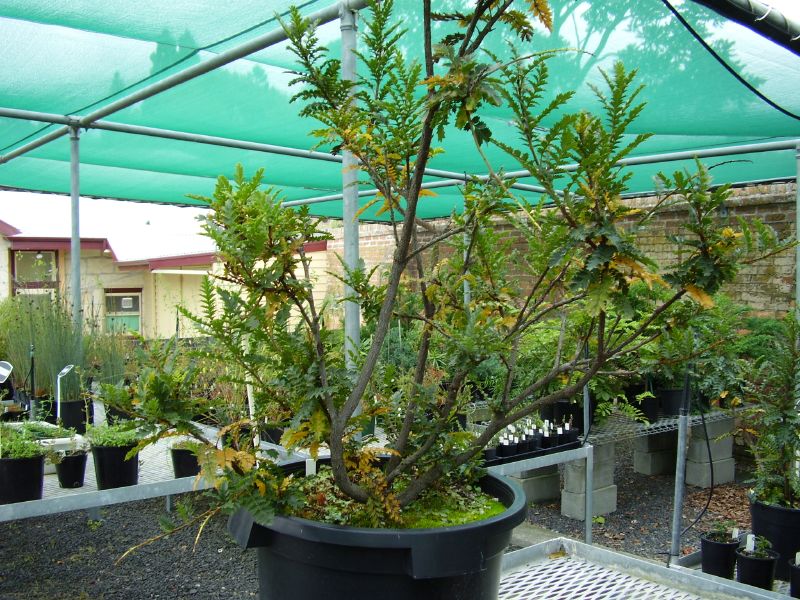- Lomatia tasmanica
taxobox
name = King's Lomatia
image_caption = "Lomatia tasmanica" inHobart Botanical Garden
status = CR
status_system = EPBC
status_ref = [http://www.deh.gov.au/cgi-bin/sprat/public/publicspecies.pl?taxon_id=3745]
regnum =Plantae
unranked_divisio =Angiosperms
unranked_classis =Eudicots
ordo =Proteales
familia =Proteaceae
genus = "Lomatia "
species = "L. tasmanica"
binomial = "Lomatia tasmanica"
binomial_authority = W.M.Curtis|King's Lomatia ("Lomatia tasmanica") is a
Tasmania n shrub from the familyProteaceae . The plant has shiny green leaves and bears pink flowers, but yields neither fruit nor seeds. Only one colony of King's Lomatia is known to be alive in the wild. It is also sometimes called "King's Holly", though it is not aholly .King's Lomatia is unusual because all of the remaining plants are genetically identical. Because it has three sets of
chromosome s (a triploid) and is therefore sterile, reproduction occurs only vegetatively: when a branch falls, that branch grows new roots, establishing a new plant that is genetically identical to its parent.Although all the plants are technically separate in that each has its own root system, they are collectively considered to be one of the oldest living plant clones. Each plant's life span is approximately 300 years, but the plant has been cloning itself for at least 43,600 years (possibly up to 135,000 years). This estimate is based on the
radiocarbon dating offossil ised leaf fragments that were found 8.5 km away. The fossilised fragments are identical to the contemporary plant in cell structure and shape, which indicates that both plants are triploid and therefore clones due to the extreme rarity of the occurrence of triploidy.History
In 1937 Charles Denison "Deny" King discovered the plant while
mining tin in the remote southwest of Tasmania. TheTasmanian Herbarium named the plant in King's honour after he sent specimens to be identified in the 1960s. The plant group that King discovered in 1937 has disappeared (and likely died out), and the sole remaining group of approximately 500 plants covers a 1.2 kilometer-long area in the extreme southwest of Tasmania. This area is prone to fires and other natural threats to the plants, so Tasmania has begun an effort to develop other populations in controlled environments such as theRoyal Tasmanian Botanical Gardens . (Because of its fragility and rarity, their specimens are not on display to the public.) Due to its inability to reproduce sexually, there is no possibility of increasing the plant's genetic diversity to promote disease resistance.References
*
*
*
* [http://mentor.lscf.ucsb.edu/course/summer/eemb127/papers/lynch_etal_1998.pdf "Aust. J. Bot." 46: 25–33, 1998.]
*
Wikimedia Foundation. 2010.
